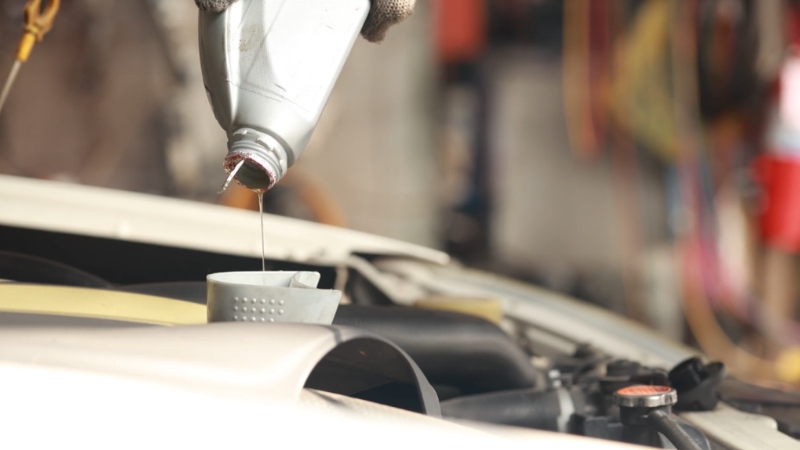
Share Post:
The easiest and most effective way to remove coffee and food stains from car seats—whether cloth or leather—is to blot immediately, then treat the area with a mild upholstery cleaner, soft-bristled brush, and clean microfiber towel. For cloth seats, use a water-based fabric cleaner or a mix of white vinegar and dish soap. For leather, use a pH-balanced leather cleaner followed by a conditioning treatment to prevent cracking.
If the stain is fresh, a two-minute blot-and-spray routine can prevent it from setting. But if it has dried or seeped into the fabric, you’ll need to use a deeper extraction method, such as cleaning the interior with steam or a portable upholstery cleaner. The goal is to lift the stain without saturating the seat foam, which can cause odor or mold.
Table of Contents
ToggleMaterial-Based Cleaning Strategies
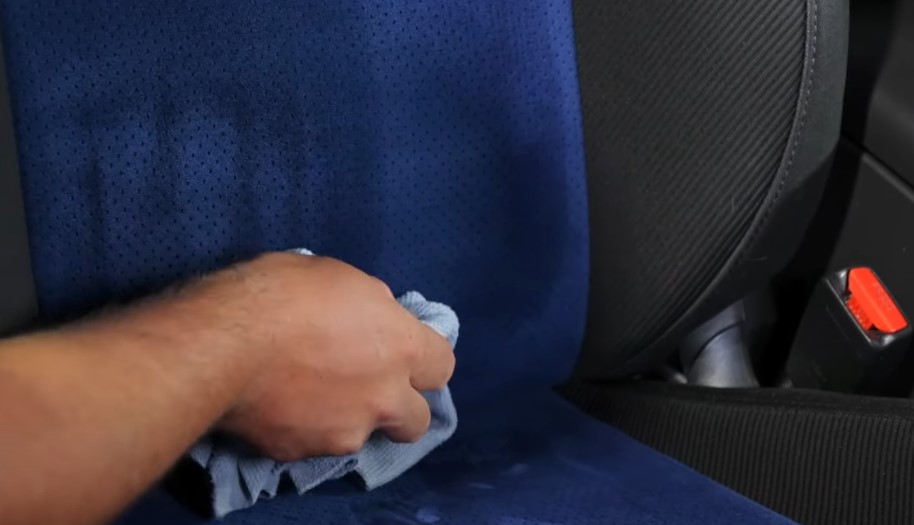
| Seat Material | First Response | Cleaning Method | Tools Required | Common Mistakes to Avoid |
| Cloth / Fabric | Blot with towel, apply the mix | Spray 1:1:1 water–vinegar–soap, agitate gently, blot again | Soft brush, microfiber towels | Soaking fabric, scrubbing too hard |
| Leather | Blot with microfiber only | Apply leather cleaner, wipe clean, and condition after drying | Leather sponge, applicator cloths | Using alkaline cleaners, skipping conditioner |
| Vinyl / Faux Leather | Wipe with warm soap solution | Clean with a soft sponge, rinse, and dry | Sponge, bucket, clean towel | Abrasive scrubbers can scratch the surface |
| Alcantara / Suede | Blot only, no rubbing | Use dry foam cleaner, brush lightly after drying | Suede brush, microfiber cloth | Applying water can cause permanent matting |
Why material matters:
Cleaning car seats is not a one-size-fits-all. Fabric seats absorb liquids deeply and must be cleaned without soaking the foam beneath. For them, the vinegar solution breaks down tannins and oils without leaving soap residue.
Leather is more delicate than it seems—improper products can strip its oils, leaving it dry or cracked. It’s essential to clean leather in circular motions and then rehydrate it using a leather conditioner, especially in hot climates.
Vinyl resists most stains but is easily scratched if harsh brushes are used. Alcantara, commonly found in luxury interiors, can be permanently disfigured by water; dry methods only. Recognizing what you’re working with prevents secondary damage during cleaning.
Stain Type and Removal Techniques
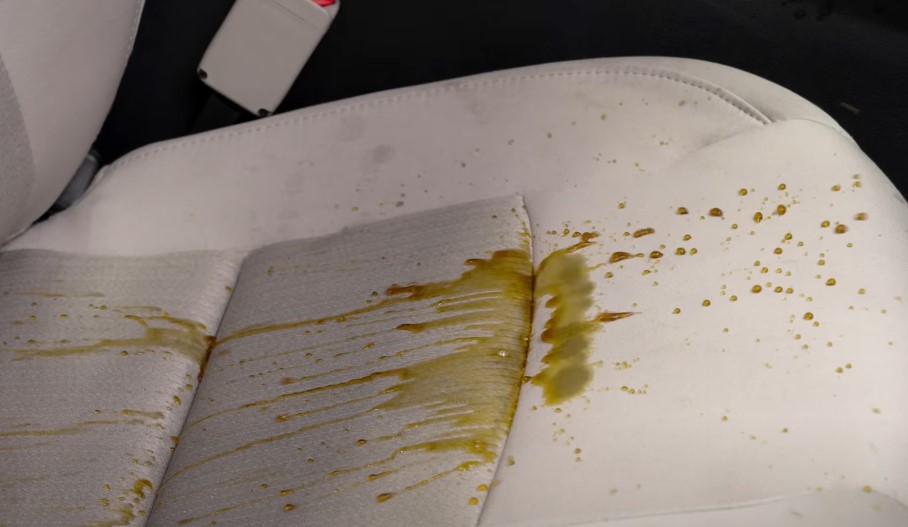
| Stain Type | Best Cleaning Approach | Apply Time | Notes |
| Black Coffee | Warm water + soap + vinegar mix | 3–5 minutes soak | Blot immediately first; avoid rubbing as it spreads the stain |
| Cream-Added Coffee | Vinegar mix + baking soda (if oily) | 5–7 minutes dwell | Fats and sugars require more work; repeat if a sour odor develops |
| Tomato Sauce / Ketchup | Enzyme-based cleaner | 10 minutes of sit time | Enzymes break down proteins; do not scrub hard, or the color may smear |
| Greasy Foods (fries) | Degreasing upholstery cleaner | 7–10 minutes | Needs repeated lifting with a towel; avoid drying between passes |
| Chocolate | Mild soap + vinegar, warm water | 5 minutes | Solid bits must be scraped gently before liquid cleaning begins |
Why technique matters:
Different substances have different chemical compositions, and that changes how you approach the cleanup. Basic black coffee is acidic, but easy to clean if caught early. Cream and sugar complicate things—sugar leaves sticky residues, and dairy can cause sour smells.
For oily food, using a degreaser is crucial. A regular soap solution won’t cut through lipids, and residue will remain in the weave. Tomato-based products contain natural acids and pigments that penetrate fast; enzymes are the safest way to lift them.
Chocolate, being both sugary and fatty, must be approached in layers: first scraping solids, then blotting gently. If results are not perfect, resist the urge to scrub hard—multiple gentle rounds are safer and more effective.
DIY Fabric Cleaner for Cloth Car Seats
| Ingredient | Amount |
| Warm Water | 1 cup |
| Dish Soap (unscented) | 1 tablespoon |
| White Vinegar | 1 tablespoon |
| Optional: Baking Soda | ½ teaspoon |
How and why it works:
This homemade cleaner targets common car spills efficiently and safely. The warm water dissolves residue, the soap lifts oils, and the vinegar neutralizes odors and acidic stains. It’s especially useful for recent food or drink spills.
Apply the solution using a spray bottle or sponge, and work it in gently with a brush. Blot with a microfiber towel. The optional baking soda adds mild abrasiveness for surface buildup. Importantly, this formula avoids strong scents or dyes that commercial cleaners often include.
When used on cloth seats, it’s safe, inexpensive, and leaves minimal residue—perfect for regular use. For chronic or deep-set stains, this solution works best as a pre-treatment before a deeper clean.
Leather Seat Cleaning and Conditioning
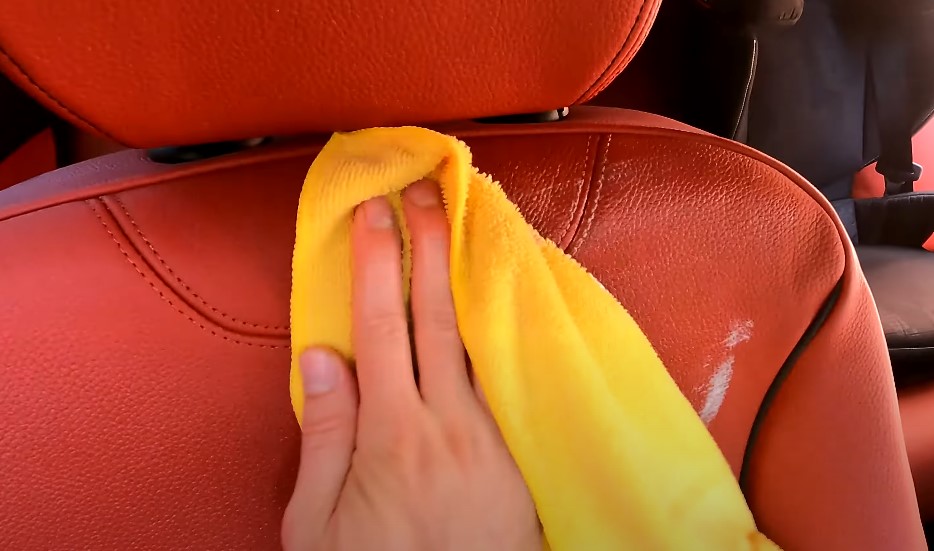
| Step | Action |
| Step 1 | Vacuum loose particles, especially seams |
| Step 2 | Apply pH-balanced cleaner using a soft sponge or applicator |
| Step 3 | Wipe with a microfiber towel in gentle circles |
| Step 4 | Apply leather conditioner after the surface dries |
| Step 5 | Buff gently with a dry cloth to finish |
Protecting your leather:
Leather reacts poorly to both neglect and overcleaning. Using harsh or multi-purpose cleaners can strip its natural oils, causing it to dry out and crack. A good pH-balanced leather cleaner lifts dirt while keeping the fibers soft.
When You Should Choose Full Interior Detailing
View this post on Instagram
A post shared by Jamin’s Perfect Touch | Auto Detailing (@jaminsperfecttouch)
| Problem | Detailing Solution |
| Stain soaked into the seat padding | Hot water extractor, low-moisture steam |
| Odor remains after cleaning | Enzyme deodorizing foam, ozone treatment |
| Leather surface cracking | Rehydration, filler, protective coating |
| Multiple stains over time | Full upholstery shampoo and fabric seal |
Why is detailing sometimes necessary?
Interior detailing isn’t just about making the car look showroom-ready—it’s often the only solution when DIY options fall short. If a spill has penetrated foam layers or created lingering odors, surface wiping won’t help.
Professional services use hot water extractors or dry steam systems that clean without soaking, removing both visible stains and invisible bacteria. For leather, detailing can rehydrate surfaces that have already dried and started to flake.
It’s also a good preventative step: applying fabric or leather sealants after detailing makes future spills much easier to clean. For cars used daily for commuting, transporting kids, or eating on the go, one detail per year keeps the cabin hygienic and protects resale value.
Preventing Future Stains with Small Habits
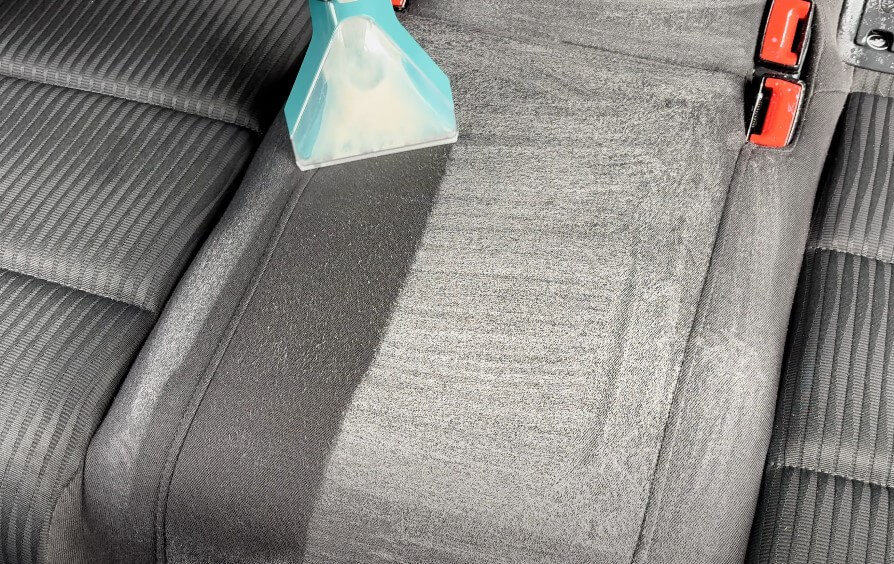
| Tip | Why It Helps |
| Keep microfiber towels in the ve box | Fast blotting is 80% of stain prevention |
| Use seat covers for frequent eating | Shield fabric from direct spills and grease |
| Avoid cream-based drinks in transit | Dairy smells and stains worse when dried |
| Scotchgard or other fabric protector | Adds a layer that repels liquids and makes cleanup easier |
| Vacuum weekly | Loose particles absorb moisture, making stains more likely |
Proactive cleaning keeps stains from setting:
Most drivers only react to stains when they become a visual or olfactory problem, but regular maintenance avoids both. Keep at least two microfiber towels in your glove box or door pocket. That lets you blot any spill instantly, before it soaks through.
Seat covers can be washed weekly and protect your real upholstery. If you regularly snack or drink in the car, using a washable seat cover is one of the easiest ways to protect your original upholstery. Avoid dairy-based drinks in the car—they create odor fast when spilled and are harder to remove than black coffee. Finally, applying a product like Scotchgard creates a protective barrier that makes future spills less of a headache.
Conclusion
Getting coffee or food out of car seats is less about expensive chemicals and more about speed, material-specific cleaners, and gentle technique. Blot within the first minute, match your cleaning solution to the seat surface, and work in light passes rather than aggressive scrubbing.
Cloth seats respond best to a warm water–vinegar–soap mix, leather demands a pH-balanced cleaner plus conditioner, and specialty fabrics like Alcantara must stay almost dry. For stubborn discoloration or lingering odors—especially when liquids have soaked into the padding—professional extraction is the only route to a truly deep clean.
Finally, preventive habits such as stashing microfiber towels in the glove box, using washable seat covers, and applying fabric or leather protectant will save hours of work down the line. Master these basics and you’ll keep your interior looking sharp, smelling fresh, and retaining its resale value with minimal effort.
Related Posts:
- Easiest Way to Replace Cabin Air Filters in Under 10 Minutes
- White Smoke Coming from Your Car's Exhaust? Causes…
- Coolant Leak from the Bottom of the Car - Causes and…
- Car Clicking But Won’t Start? Common Causes and How…
- 10 Reasons Your Car Overheats When Sitting Idle (And…
- Why Does My Car Smell Like Gas? Common Causes and Solutions






